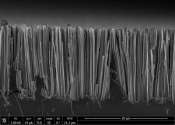Silicon nanowires fabricated via imprinting technology could be the future for transistor-based biosensors
Korean researchers are improving the fabrication of transistor-based biosensors by using silicon nanowires on their surface.

Korean researchers are improving the fabrication of transistor-based biosensors by using silicon nanowires on their surface.
Nanophysics
Mar 1, 2017
0
7

A simple technique for producing oxide nanowires directly from bulk materials could dramatically lower the cost of producing the one-dimensional (1D) nanostructures. That could open the door for a broad range of uses in lightweight ...
Nanophysics
Jan 19, 2017
0
780

By suspending tiny metal nanoparticles in liquids, Duke University scientists are brewing up conductive ink-jet printer "inks" to print inexpensive, customizable circuit patterns on just about any surface.
Nanophysics
Jan 4, 2017
0
859

(Phys.org)—A team of researchers at the University of Chicago has developed new technology that allows for recording and viewing the process by which a silicon nanowire is consumed by an individual cell. In their paper ...

Do you think your computer is fast enough? Think again. The computers of the future could work almost at the speed of light! Nanophotonics, the study of light at the nanometer scale, could indeed bring the speed of our technology ...
Nanophysics
Nov 28, 2016
0
27

A new, ultrathin film that is both transparent and highly conductive to electric current has been produced by a cheap and simple method devised by an international team of nanomaterials researchers from the University of ...
Nanophysics
Nov 22, 2016
0
386

Controlling the flow of heat through semiconductor materials is an important challenge in developing smaller and faster computer chips, high-performance solar panels, and better lasers and biomedical devices.
Nanophysics
Nov 10, 2016
0
3363

Tinier than the AIDS virus—that is currently the circumference of the smallest transistors. The industry has shrunk the central elements of their computer chips to fourteen nanometers in the last sixty years. Conventional ...
Nanophysics
Nov 9, 2016
0
4598

Physicists from the Lomonosov Moscow State University have worked out a new and more eco-friendly method of obtaining silicon nanowires that replaces hydrofluoric acid (HF) with ammonium fluoride (NH4F).
Nanophysics
Oct 19, 2016
0
0

A new type of atomic force microscope (AFM) uses nanowires as tiny sensors. Unlike standard AFM, the device with a nanowire sensor enables measurements of both the size and direction of forces. Physicists at the University ...
Nanophysics
Oct 17, 2016
0
2567